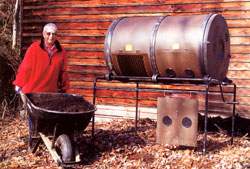
You've seen the ads: "Now you can have dark, rich
compost in just a few weeks!" What an appealing
message. Whether you grow flowers, vegetables, herbs
or houseplants, compost is "black gold" in
the garden. We never have enough of it, and can't make
it fast enough. Compost tumblers, the ads say, can give
us a steady supply every couple of weeks. Designed so
you can crank, turn or roll the container to turn and
aerate the compost, tumblers come in several sizes.
Before you run out and buy one, however, be aware that
those headlines are advertising hyperbole at best. In
our tests, tumblers did not produce finished compost
any faster than a well-managed compost bin or open pile.
To be sure, the ingredients appear to be composting
faster because you are likely to turn the contents more
often in a tumbler, thus introducing air—one of
the four vital ingredients (the others being nitrogen,
carbon and water)—that is necessary to turn vegetable
matter into compost. But if you build an open pile the
same size as a tumbler's capacity, use the same ingredients
in both and turn the open pile whenever you rotate the
tumbler, they will produce compost in the same general
time frame. So, why should you buy a compost tumbler?
Last summer we conducted afield test of various compost
tumblers versus open compost piles. Although most of
us at MOTHER use cold composting methods (substituting
time for the work of maintaining a hot pile), we ran
a hot pile as a control.
Under our environmental conditions, both the open (hot)
pile control and the tumblers yielded rich, finished
compost in about 10 weeks—a far ay from the 14
days some of the manufacturers claim. The tumblers were
certainly easier to use than turning an open pile with
a pitchfork, but they did not appreciably increase the
speed of production when compared to a properly managed
open pile. Ease of turning is probably the main benefit
tumblers offer, but as you will see below, some are
easier to turn than others.
Although the decomposition time is not increased, compost
tumblers do have advantages in addition to ease of turning.
By and large, they are clean, neat, unobtrusive, pest-resistant
and odor-free. Because of this, tumblers often can be
used in urban and suburban areas, where local laws or
restrictive covenants may prohibit open compost piles.
One pleasant surprise during the testing, in what turned
out to be a drought year, was that the enclosed tumblers
retained moisture better than the open pile, which had
to be watered frequently.
TUMBLER STYLES
Compost tumblers fall into four general categories based
on their construction:
Crank-operated drums. A horizontally mounted
drum rests on a raised framework. A crank assembly lets
you turn the drum easily, while the internal baffles
help mix the materials, adding air.
Because the drums are raised relatively high, emptying
them is simple. Merely push a wheelbarrow under the
drum, position the door and open it. Compost pours directly
into the wheelbarrow.
This style of tumbler tends to cost about twice as much
as other styles. But, as with anything else, you get
what you pay for. In this case, you trade money for
ease of operation.
The Mantis ComposT-Twin (Page 105) and the ComposTumbler
(Page 108) are examples of this design; the former has
a double drum and the latter has a single drum (available
in two sizes).
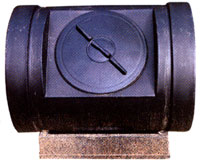 Center-axle
drums.
Center-axle
drums. A vertically mounted drum rotates around
a central, horizontal axle supported by a wood, metal
or PVC frame. Operation is generally easy, particularly
with the models that have doors on both ends. The central
axle acts to break up and mix the materials. Most of
these tumblers are mounted low to the ground, however,
so emptying them can be a chore unless you have a low-boy
wheelbarrow that happens to fit under them.
The Urban Compost Tumbler (UCT) and the Tumbleweed are
this type.
Base rolling drums. A
horizontally configured drum rolls on a ground-level
base. Some of them actually have rollers, while others
have molded rounded points to suspend the drum and let
it rotate. Obviously, the tumblers with rollers are
easier to turn. To help make rotating easier, several
of this style have steps molded into the body, so you
can use your feet and legs to turn them, thus theoretically
easing back strain.
Because the base rolling tumblers virtually sit on the
ground, emptying them can be awkward. You have to shovel
the compost out—through relatively small openings—rather
than pouring it.
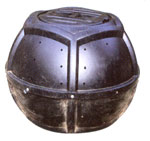
Typical of this design are the Envirocycle, the Step-down
Composter and the EZ Composter
Roll-around spheres. These
are giant molded angular balls that you fill with composting
material and then roll around your yard. The idea is
initially intriguing; in practice, however, they tend
to he the most awkward to use and the most difficult
to empty.
Roll-around composters are not really round, but are
faceted like a geodesic dome. As a result. they only
roll on what would be their equator. And, instead of
rolling like a snowball, they swing to the left or right
in sharp arcs. The heavier they are loaded, the less
control you have.
The Bio Orb (left) and the Large Batch Composter are
examples of this style.
MOTHER'S
TUMBLER TEST RESULTS
Our field testers ranked the tumblers on
a scale of one to five, with one (1) being
the poorest functioning and five (5) the
best. We found all of the tumblers were
pest-proof and produced finished compost
in about the same length of time.
|
| Name |
Ease of assembly |
Ease of use |
Visual impact |
Capacity |
Price |
Overall rating |
| ComposT-Twin |
4 |
5 |
2 |
(2) 12 cu. ft. |
$349 |
5 |
| Envirocycle |
5* |
4 |
4 |
7 cu. ft. |
$140 |
4 |
| Tumbleweed |
4 |
4 |
4 |
7 cu. ft. |
$180 |
4 |
| UCT -large |
3 |
4 |
3 |
8.5 cu. ft. |
$129 |
4 |
| UCT -small |
-- |
-- |
-- |
7.3 cu. ft. |
$110 |
4 |
| EZ Composter |
5* |
2 |
2 |
11 cu. ft. |
$229 |
2 |
| Bio Orb |
1 |
2 |
2 |
23 cu. ft. |
$97 |
1 |
| *pre-assembled unit |
|
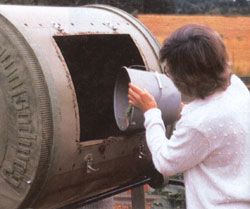 |
| The ComposTumbler shown at right has a "little brother" called the Back Porch. It holds 3 cubic feet, has rollers on the bottom of the frame and sells for $199. |
FEATURE PROS AND CONS
Once you have decided which kind of tumbler you want,
look at the specific features of each. It's the little
things that can make or break a design.
For instance, compare the Envirocycle to the EZ Composter.
The former has a hinged door. The latter has a round
hatch with finely threaded screws. As a result, loading
and unloading the Envirocycle is considerably easier
than loading and unloading the EZ Composter, which has
a hatch that is difficult to screw down even when the
unit is new, let alone after dirt and debris clog the
threads.
Among center-axle types, some, such as the Tumbleweed,
open at both ends, while others, such as the Urban compost
Tumbler., open only atone end. Having openings on both
ends makes loading and unloading simpler. However, the
extra air flow of the UCT's patented core-aeration system,
which precludes having both ends open, might he worth
the trade-off.
Capacity also can be an issue. Many models come in more
than one size. At first blush, the larger size seems
to make sense because it produces more compost in the
same amount of time as a smaller one. But the larger
one also might he heavier and more difficult to operate.

There's another aspect of capacity to consider. Composting
speed is a function of the last items to he added. That
is, you won't get a full load of compost unless you've
put in a full load of organic material. This doesn't
mean you can't add material a little at a tune. What
it does mean, however, is that "time to completion"
is measured from the last of those small additions.
Because of this, you may want to have more than one
unit. Start by completely filling one with a mixture
of brown and green compost material. Examples of brown
material are fine mood chips, brown weeds, straw, leaves
and kitchen scraps; examples of green material are grass
clippings, green garden cast-offs and manure.
While that batch "cooks," you can slowly fill
another unit.
This is the idea behind the ComposT-Twin: You can have
one bin filled and composting while you are adding fresh
ingredients to the second bin.
OPERATING FACTORS
Whichever unit you choose, you should be aware of certain
operational factors:
1) Ignore recommendations to
use compost accelerators. About half the manufacturers
still recommend this practice, yet study after study
has shown that such additives have no appreciable effect
on the composting process.
2) The proportion of green material to brown
is more crucial in a closed tumbler than in
an open pile. If you don't add at least 40 percent browns,
you'll end up with a slimy, smelly mess instead of compost.
If nothing else is available, keep a bag of leaves or
a bale of straw handy and use it as necessary to maintain
the balance. In most cases where users have reported
poor results, it turns out they have been adding only
grass clippings and kitchen scraps to the unit.
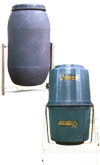 3)
3)
All tumblers are pest-proof to rodents, dogs and other
animals—not to insects. When you open a tumbler,
be prepared for a cloud of gnats
to emerge. The fact is, these same gnats hover
over open compost piles, but you are less aware of them
because you don't encounter them en masse.
4) Monitor the moisture content.
Tumblers retain moisture letter than open piles, so
you don't need to add much. Usually, grass clippings
alone provide more than enough moisture. Your working
pile should feel like a clamp sponge.
If its wetter than that, leave the door open awhile
so it can dry out. Occasionally you may have to add
a small amount of water. If so, add no more than a cup
at a time, and be sure to tumble the contents after
each addition.
5) Air is crucial to the composting process.
Periodically check to ensure the vents in your composter
haven't been clogged by organic material. If you think
the mix isn't getting enough air, rotate tile tumblers
more frequently.
